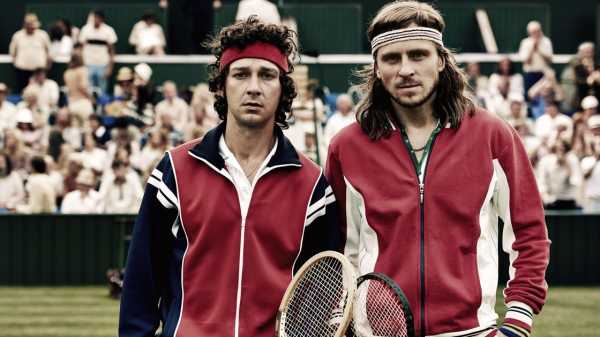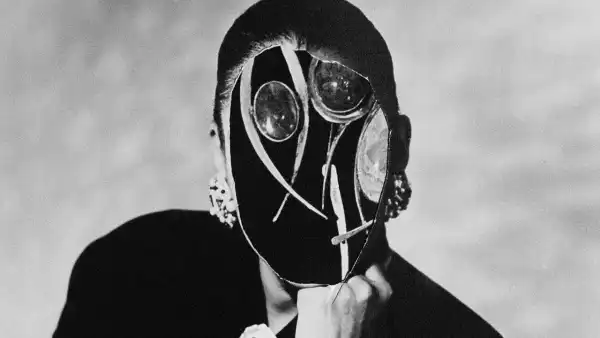
The name “Borg and McEnroe” (which was released on Friday in limited release and on video on demand) is not lying: Bjorn Borg is the main character, John McEnroe secondary. Although the main claim to fame stemming from two names McEnroe tantrum on court, directed mainly at referees and linesmen, film Directed by Danish Director Janus Metz, script, Swedish writer and film Director Ronnie Sandal—looks much more closely at the Borg’s youth and his rise to tennis preëminence. The campaign focused on the 1980 Wimbledon, which Borg, after twenty-four years (played by Sverrir Gudnason), with four Wimbledon already under his belt, and McEnroe (played by Shia LaBeouf), twenty-one, with anyone met in the finals. But most of the film is the background, and the story is of Borg, because the Sandal and Mets find a paradox in the fact that, according to them, has a Borg character, and the story of its rise, much more complex and interesting than McEnroe.
Although Borg Reputation was cold and unemotional tennis robot, whose style of play, with its methodological core game and accurately placed shots, matched his impassive temperament, the filmmakers took care to show that the Borg were actually possessed a fiery temper, like a young competitor (he played as a child, Leo Borg, Bjorn in real life son, and in the mid-teen Markus Mossberg), he was a temperamental troublemaker, as McEnroe was, and that his outbursts almost cost him his lead in Swedish tennis. His Savior was his coach, Lennart Bergelin (Stellan Skarsgard), who in the film helps him to recognize the competitive advantage that his “anger, fear, and panic,” let him control his behavior so that these fires are not to interfere in his game, but rather the silence of fuel.
During the campaign, Borg didn’t spend a lot of time thinking or talking about McEnroe, but McEnroe, Borg is the object of obsession. In one of the films most joyful scene in London night club on the eve of the tournament, McEnroe for a night of partying with a group of tennis players, which includes another resident of new York, fitsgerald (Robert EMMS), who, in rapid-fire monologue illustrated with dramatic inserts, McEnroe explains the complex nature of the enemy, he is scheduled to meet in the final. Over the DIN of disco music and surrounded by young women who are the object of his lustful attention, talkative and bright Gerulaitis (died in 1994) says that Borg is Intrusive, and it goes through numerous varieties of these obsessive thoughts—how he feels about feet fifty the racket that his coach strings for him; he only allows parents to attend the tournament every year, and then requires them to wear the same clothes that they did in previous times; he keeps his room (the same one each time) refrigerator-cold to keep the pulse below fifty; that, in the first row is always the same place and always takes two towels. Gerulaitis summarizes their findings: “they say he’s an iceberg, but he’s actually a volcano, while maintaining all the while . . . boom!”
Gerulaitis, whose excellent location in the campaign (he was Borg’s practice partner and a close friend and, in 1977, lost to him at Wimbledon, in a long and grueling match—details that the script leaves) turns him into a willing mouthpiece for the Director and screenwriter, also says that four Borg Wimbledon and other Grand slam victories make him a ruthless target of the fans, promoters and operators, which he tries to escape, making it “the loneliest guy on the planet.” In particular, that “Borg and McEnroe” dramatizes the invasion of the media machines in the same secular realm of world-class tennis. In the beginning of the film, Borg is seen shortly before his departure in 1980 Wimbledon tournament in Monaco, where he lives, pursued by autograph seekers and swarmed by fans, communicating with them, happily, impatiently, indifferently—but, in any case, adding the problems newfound celebrity in their field of sports problems.
“Borg and McEnroe” has the force of a bookmark point it, filmmakers to watch on line, find the bright mode, essentially, the essay statement on the main idea of the film. What oratorical clarity of purpose, it seems, filled in their approach to the rest of the film; Gudnason performance as a Borg, mask-like emptiness that under the calm and tranquility to escape the uncertainty, keeps a wary tension, which is tested in the form, and consciously manipulated Lennart, a former tennis feeling. Metz writes of a collision of a wise but relentless Lennart (role Skarsgard lives with a strong dialectical intelligence) and tightly controlled, but impulsive Borg in a reverent, well-confrontational wide screen compositions shrewdly edited to leave extra breath heavy silence around the dialogue and gestures. (Metz is the same way with open eyes and a curious approach to the Borg scene with his fiancee, Mariana Simionescu, played by Tuva Novotny, whose practical care to bait the Borg and the burden of fame combined with her outspoken determination and a good guide him through the world, that he will dream until the end.) In fact, the film implies that, despite appearances to the contrary, Borg and McEnroe were internally very similar, and different mostly in their behavior. What drama is that the pressure to maintain appearances to keep his fury under control and directed in the right direction, to pay a very high emotional price for Borg.
And McEnroe, he was introduced as a kind of fanatic—a key element of his backstory shows him as a child (played by Jackson Dunn), who gave his father (Ian Blackman), at a dinner party, as a genius of mathematics. During the campaign the Wimbledon that systematic exploration is on display in his hotel room, where he scheme of the UCL on the wall and plans for its implementation up to the final, where he expects to face Borg. But most of what the film shows about professional life McEnroe is that everyone knows he was seen ranting at the officials and punished and punished for his outbursts. LaBeouf does not leave much of an impression in the role because he didn’t give a lot of work—there, see, and explosive, to provide a wild foil to the Borg, conflict, and to offer a measure of lustful ignorance of his bad behavior, which is expected during the match.
This match, of course, that the film is building towards. Almost the entire last third of the film is dedicated to the final battle on the court Wimbledon-centre, and that’s where Mets Hits a cinematic wall. Five-set, almost a four-hour battle, complete with its famous thirty-four-point tie-break (during which McEnroe saved five points), distilled to the key points and powered that from the point of view of the character of interest only to the extent that it shows McEnroe managing to keep his temper—with a little help from the Borg, which, in change, offers him words of support to keep his focus on the game. Film Directors have the power to shoot sports in ways that differ fundamentally from the traditional model in which television programs to limit it. Metz does not take advantage of these opportunities; his images coincide only illustrate the results of each significant point that the speakers calls. No emphasis on footwork, violent stopping and starting on the court in frightening power to serve or smash. There are no descriptions of the players special aesthetics—we only note, the game commentators, the contrast between Borg and McEnroe base game no-rushing style, but Metz has no visual perception to believe that the contrast in the images. “Borg and McEnroe” is anecdotally pleasing, psychologically nuanced and sharply maneuverable nature of the Borg, but despite the extended scene of the famous match, it’s not satisfying tennis the movie at all.
Sourse: newyorker.com






